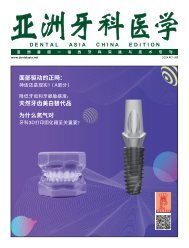Dental Asia March/April 2019
For more than two decades, Dental Asia is the premium journal in linking dental innovators and manufacturers to its rightful audience. We devote ourselves in showcasing the latest dental technology and share evidence-based clinical philosophies to serve as an educational platform to dental professionals. Our combined portfolio of print and digital media also allows us to reach a wider market and secure our position as the leading dental media in the Asia Pacific region while facilitating global interactions among our readers.
For more than two decades, Dental Asia is the premium journal in linking dental innovators
and manufacturers to its rightful audience. We devote ourselves in showcasing the latest dental technology and share evidence-based clinical philosophies to serve as an educational platform to dental professionals. Our combined portfolio of print and digital media also allows us to reach a wider market and secure our position as the leading dental media in the Asia Pacific region while facilitating global interactions among our readers.
You also want an ePaper? Increase the reach of your titles
YUMPU automatically turns print PDFs into web optimized ePapers that Google loves.
Clinical Feature<br />
Glass Ionomer Sealant<br />
for Proactive Intervention<br />
Occlusal decay and its<br />
consequences have a major<br />
impact on the dental health<br />
of our patients. It is the<br />
single most common chronic<br />
childhood disease worldwide 1 and its<br />
results affect our patients throughout<br />
their lives. Molars and premolars are<br />
vulnerable, especially during their eruption<br />
phase. Deep pits and fissures provide an<br />
ideal environment for bacteria to thrive,<br />
digesting carbohydrates and creating<br />
acid which leads to the demineralisation<br />
of susceptible immature dental surfaces.<br />
Purpose of placing pit and fissure<br />
sealants<br />
The most efficient way to prevent pit<br />
and fissure caries is through the sealing<br />
of the vulnerable tooth surfaces, from<br />
the cariogenic bacteria and fermentable<br />
carbohydrate substrates left on the teeth<br />
during mastication. This is best achieved<br />
by placing a physical barrier in the form<br />
of a seal on the pits and fissures. 2<br />
Dentists have been attempting to find<br />
conservative, minimally invasive ways to<br />
treat pit and fissure areas for many years.<br />
In 1955, Dr. Michael Buonocore suggested<br />
that it would be possible to prevent caries<br />
by sealing pits and fissures with a bonded<br />
resin material. The appropriate materials<br />
became available only later, and he<br />
published a further paper on the use of<br />
pit and fissure sealants in 1967. 3<br />
The first permanent molars are a<br />
cornerstone in the development of the<br />
adult dentition. First permanent molars<br />
often erupt before the patient and/or the<br />
parent is even aware of their existence.<br />
The partially erupted permanent first<br />
By Fay Goldstep DDS, FIADFE, FASDA<br />
molar is very difficult to keep caries-free<br />
during its eruption phase. Therefore, it<br />
requires between 12 and 18 months to<br />
fully erupt into occlusion with the existing<br />
teeth in the arch. 4 On the other hand,<br />
bicuspids only need three to six months<br />
to reach full occlusal height.<br />
During this time, the patient experiences<br />
difficulty in cleaning and reaching the first<br />
molar due to its reduced height unless<br />
major effort is made by the patient to<br />
achieve contact. However, this is not<br />
likely possible in a young child. Hence,<br />
the occlusal surface of the first permanent<br />
molar is rarely brushed and is often<br />
covered with plaque and food debris in<br />
a low pH environment. 5 This is further<br />
exacerbated if the tooth remains under an<br />
operculum (gum flap covering an erupting<br />
tooth) for a long period of time. These<br />
factors lead to an erupting tooth that<br />
can easily become carious on its occlusal<br />
surface by the time it fully erupts. 5<br />
Materials to use<br />
The objectives for the pit and fissure<br />
sealant material are: to seal the area, to<br />
make the tooth surface caries resistant<br />
and to be easy to use. 6 Evidence regarding<br />
the efficacy of sealants in reducing<br />
occlusal caries is well established. 7<br />
Composite resin is the most commonly<br />
used sealant material. It seals the pits<br />
and fissures through micro mechanical<br />
means. Micro mechanical retention<br />
is created through tags after enamel<br />
etching. However, these tags are easily<br />
destroyed by contamination with saliva<br />
and this leads to the eventual failure of<br />
the resin sealant. 8 Glass ionomer (GI)<br />
sealant material is hydrophilic. Hence, it is<br />
not as moisture sensitive as hydrophobic<br />
resin materials and it offers an alternative<br />
treatment for the wet conditions in the<br />
oral cavity. 9<br />
Resin sealants have higher retention to pits<br />
and fissures than GI sealants. However,<br />
resin-based sealants have been shown to<br />
lose almost all of their protective effect<br />
once retention is lost. 10-11 In contrast to<br />
resin, even when the GI sealant appears<br />
clinically as partially or totally lost, small<br />
amounts of the material remain. The<br />
GI material stays within the depths of<br />
the fissure since it bonds chemically to<br />
the tooth and consequently the sealing<br />
effect continues. 6 This remaining material<br />
provides a barrier to the bacteria and also<br />
promotes remineralisation through the<br />
release of fluoride. 10-11<br />
Most studies have used ‘retention of<br />
the sealant’ as the end point for fissure<br />
sealant effectiveness. In addition, many<br />
studies have assumed that only a totally<br />
intact sealant (as opposed to a lost or<br />
partially retained sealant) is the criterion<br />
for effective caries prevention and clinical<br />
success. 12 But systematic reviews have<br />
not found that the sealant retention rate<br />
is a valid predictor of clinical outcomes. 12<br />
Hence, it should not be used to measure<br />
sealant success in preventing caries.<br />
Two systematic reviews 10-11 found that<br />
neither resin nor GI sealants were<br />
superior in the prevention of dental caries<br />
in children. Therefore, the choice of which<br />
material to use may have more to do with<br />
ease of use, moisture control, and patient<br />
compliance. 13<br />
Hydrophobic resin sealants do not<br />
provide the best solution for sealing<br />
permanent first molars since they are only<br />
partially erupted for a prolonged period<br />
of time and adequate isolation is not<br />
attainable. 5 Moreover, it has been shown<br />
that improperly placed resin sealants can<br />
leak and allow caries to develop unnoticed<br />
under the leaking sealants. 14 Therefore,<br />
many dentists have stopped using resin<br />
fissure sealants: too many surprises when<br />
opening up carious lesions under failed<br />
40<br />
DENTAL ASIA MARCH / APRIL <strong>2019</strong>


















